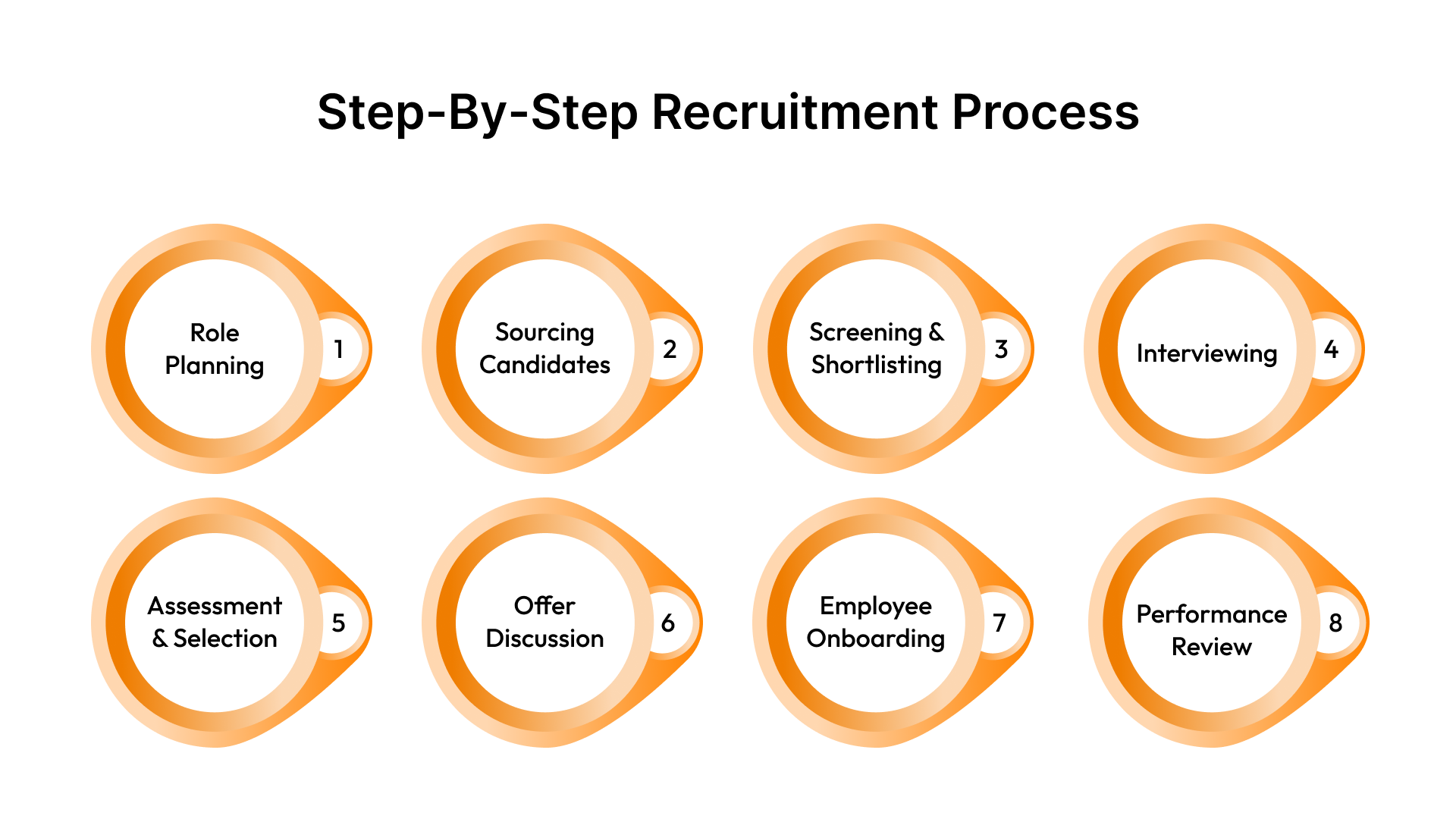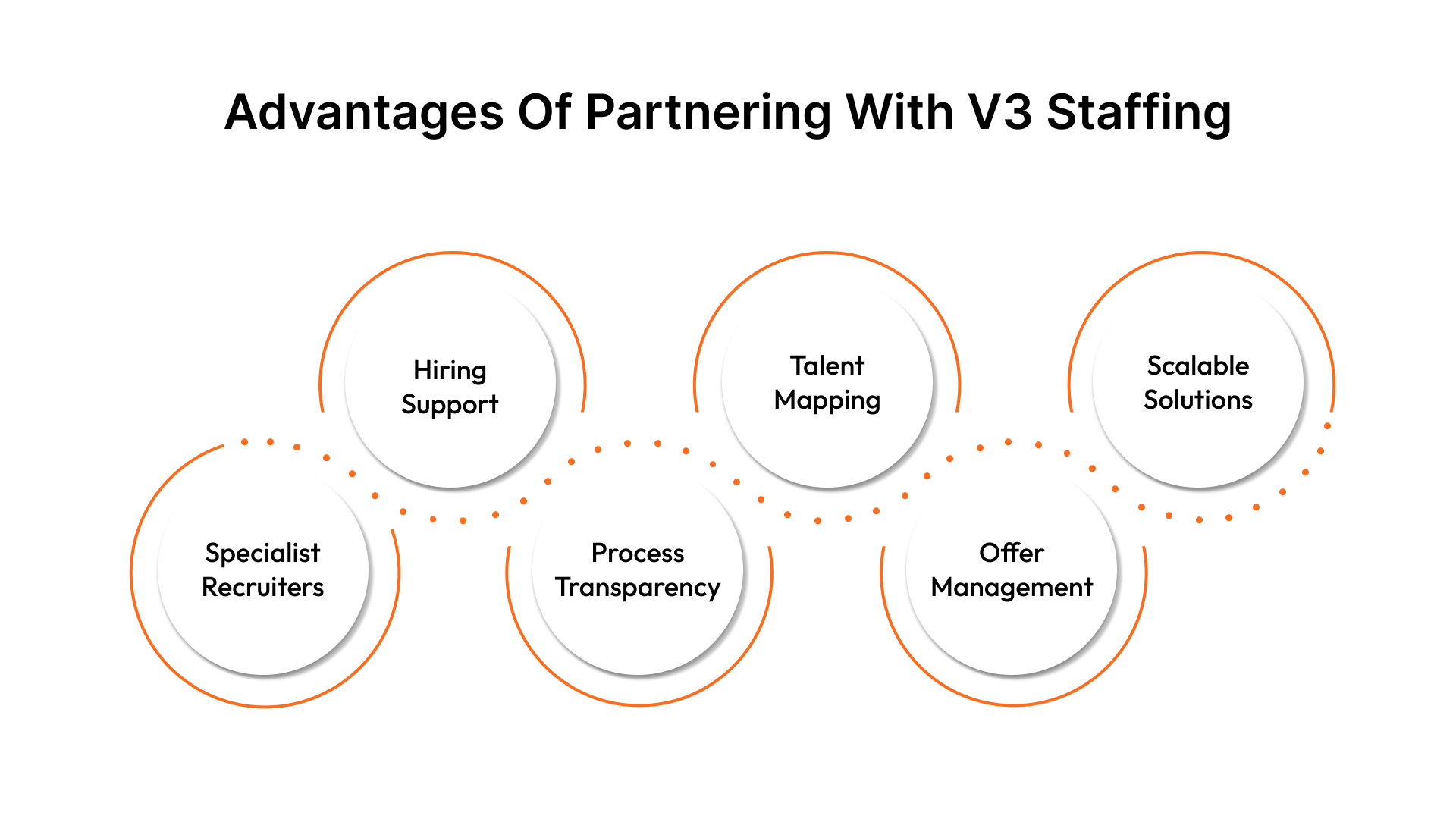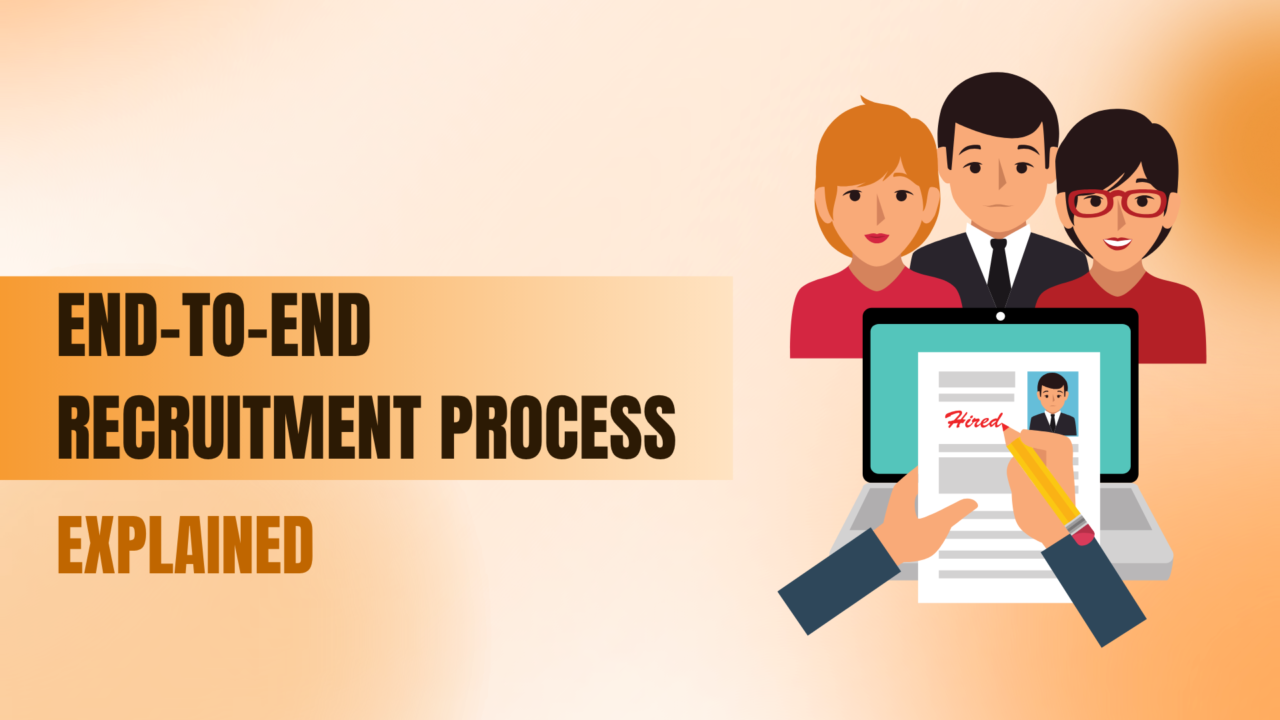As organisations scale or diversify, their ability to attract and retain the right talent becomes a strategic priority. End-to-end recruitment encompasses the complete hiring journey from the initial identification of a vacancy to onboarding and integration into the business.
Lengthy or fragmented recruitment processes often lead to talent drop-offs. A survey by Robert Half found that 57% of job-seekers lose interest in a role if the hiring process is too long. This underscores the value of a structured approach that guarantees clarity, accountability, and momentum throughout each stage of hiring.
A comprehensive end-to-end recruitment strategy provides the framework to align business goals with workforce planning, improve candidate experience, and reduce time-to-hire.
This blog explains end-to-end recruitment and highlights key considerations for building a consistent, scalable, and high-performing hiring process.
Key Takeaways
- End-to-end recruitment streamlines the hiring journey, ensuring clarity, consistency, and reduced time-to-hire.
- A structured recruitment process aligns talent acquisition with business objectives, improving candidate quality and organisational fit.
- By implementing best practices and leveraging technology, organisations can enhance hiring outcomes and employer branding.
- Partnering with recruitment experts guarantees a scalable, efficient process with specialized support at every hiring stage.
What is the End-to-End Recruitment Process?
End-to-end recruitment, also known as full-cycle recruitment, refers to the complete hiring process undertaken by an organisation to fill a role. It involves every stage of the hiring journey, starting from identifying the vacancy and defining requirements, all the way through to onboarding the selected candidate. The process guarantees that each step from requisition to candidate integration is coordinated, accountable, and aligned with business goals.
The core phases typically include:
- Job requisition and workforce planning
- Talent sourcing (internal and external)
- Screening and shortlisting
- Interviews and assessments
- Selection and offer management
- Onboarding and integration
- Post-hiring review and optimisation
Each of these stages plays a crucial role in ensuring hiring success, both in terms of candidate quality and organisational fit.
As organisations expand or introduce new business lines, hiring becomes increasingly complex. A structured end-to-end approach helps navigate this complexity by reducing inefficiencies, maintaining consistency, and offering better visibility across the entire recruitment pipeline. It also provides a measurable and repeatable framework that’s essential for scaling talent acquisition in high-growth environments.
The following section outlines the process step by step, offering practical insight into every phase.
Step-by-Step End-to-End Recruitment Process

A comprehensive hiring process is more than a checklist; it’s a structured framework that guides every stage from the initial workforce to post-hire review. Each step plays a distinct role in ensuring that organisations attract the right candidates, engage them meaningfully, and support their transition into the business with clarity and consistency.
Step 1: Job Requisition & Planning
Every successful hire begins with precise planning. This stage is focused on understanding the business requirement behind the role and ensuring leadership alignment on expectations, budget, and timelines.
- Define the hiring need: Clarify the position’s purpose, expected outcomes, and reporting structure. Assess whether the role is new or a replacement and how it supports business goals.
- Create and approve requisitions: Prepare formal job requisitions with details such as job title, location, skills required, and urgency. Obtain approvals from relevant departments or business units.
- Develop candidate-focused job descriptions: Craft clear, realistic, and appealing job descriptions that accurately reflect responsibilities, required qualifications, growth opportunities, and cultural context.
- Align on timelines and budget: Set clear expectations on hiring deadlines, budget constraints, and key stakeholders involved in the process.
This planning stage guarantees that hiring begins with clarity and alignment, reducing downstream delays or miscommunication.
Also read: Executive Search Strategies to Find Top Talent in Competitive Markets
Step 2: Sourcing Candidates
Sourcing plays a pivotal role in the recruitment process, determining the quality and availability of talent moving forward. Organisations typically begin with internal hiring before extending their search to external markets. Below is a comparison of the two approaches:
| Aspect | Internal Hiring | External Hiring |
| Source | Existing employees, internal job boards, succession plans | Job portals, agencies, social media, universities, talent communities |
| Key Benefits | Faster hiring, cost-effective, promotes retention and morale | Access to wider talent pool, fresh ideas, specialist skills |
| Tools & Channels | Performance reviews, referrals, internal mobility platforms | Job boards, ATS, sourcing tools, professional networks |
| Use Cases | Succession planning, quick backfills, career progression | Expansion, niche roles, innovation, new functions |
| Risks or Limitations | Limited pool, potential skill gaps, internal disruption | Longer time-to-fill, higher costs, onboarding complexity |
A thoughtful sourcing strategy increases the likelihood of finding candidates who meet technical requirements while also bringing fresh perspectives to the organisation.
Struggling to find the right talent? V3 Staffing’s expert recruiters and curated talent pools can help you source top candidates faster and more effectively.
Step 3: Screening & Shortlisting
Screening narrows the pool of applicants to those best suited to the role, based on qualifications, experience, and alignment with company needs.
- Use application tracking and resume parsing tools to quickly scan for role-specific skills and experience.
- Conduct pre-screen interviews via phone or digital tools to assess communication, interest, and basic fit.
- Apply structured screening criteria such as minimum years of experience, certification requirements, or domain-specific exposure.
- Collaborate with hiring managers to finalise shortlisted candidates for further rounds, ensuring business needs remain central to selection.
At this stage, clarity in criteria and communication helps avoid mismatches and guarantees that only qualified, relevant profiles move forward.
Also Read: Key Niche Skills That Are Revolutionising the IT Industry
Step 4: Interviewing
Interviews offer a deeper evaluation of a candidate’s capability, mindset, and compatibility with the team and organisation. A structured and multi-stage approach guarantees fairness and consistency.
- Select interview types based on role and stage; these may include telephonic, virtual, in-person, or panel discussions.
- Use structured interview formats with predefined questions and scoring rubrics to assess both technical and behavioural competencies.
- Adapt for external candidates by including cultural overviews or practical examples to help them understand the company context.
- Include multi-round formats, with technical assessments, leadership evaluations, and peer-level discussions to gauge both soft and hard skills.
A reliable interview stage minimises bias and helps teams align on candidate strengths and developmental areas.
Also Read: How To Ensure Quality in Your Recruitment Practices
Step 5: Assessment & Selection
Selection involves validating what’s been observed during interviews through formal assessment and background verification. This stage supports objective decision-making.
- Administer role-specific assessments such as technical tasks, case studies, or behavioural tests to evaluate job readiness.
- Conduct reference checks with past employers or peers to understand the candidate’s previous performance, conduct, and reliability.
- Use a decision matrix to compare finalists across key parameters such as skills, adaptability, and long-term potential.
- Communicate outcomes professionally, whether the candidate is selected or not, to maintain brand credibility and candidate goodwill.
The goal here is to finalise a well-informed decision based on structured data and manager consensus.
Step 6: Job Offer & Negotiation
The offer stage can be pivotal. A poorly structured offer or delayed communication often leads to candidate drop-offs.
- Craft offer letters that reflect not just salary but total compensation, growth trajectory, benefits, and expectations.
- Negotiate respectfully and transparently, using current market data to guide discussions around salary, role scope, or joining dates.
- Set expectations clearly about the role, performance metrics, and work culture to help the candidate make an informed decision.
Effective handling of this stage reinforces candidate confidence and reduces offer rejections or delays in joining.
Facing delays in offer acceptance? V3 Staffing’s offer management ensures smooth communication and faster candidate closure.
Step 7: Onboarding & Integration
Onboarding goes beyond paperwork. It’s the process of welcoming and enabling a new hire to become a confident, productive member of the team.
- Begin preboarding with welcome emails, resource access, and team introductions ahead of day one.
- Create a structured onboarding plan that spans the first few weeks and covers organisational policies, tools, team workflows, and KPIs.
- Facilitate cultural integration through mentorship, buddy systems, or training sessions on company values and collaboration norms.
- Implement a 30-60-90 day plan that helps the new hire understand priorities and track their progress.
Well-executed onboarding drives early engagement, improves retention, and sets the foundation for long-term success.
Step 8: Review, Feedback & Optimisation
Hiring processes should never remain static. This final step guarantees continuous improvement based on measurable outcomes and stakeholder input.
- Collect feedback from candidates and hiring managers on the recruitment experience and process clarity.
- Monitor recruitment metrics such as time-to-fill, quality-of-hire, cost-per-hire, and source effectiveness.
- Analyse data to refine sourcing strategies, screening criteria, or interview practices.
- Close the feedback loop by sharing insights with HR teams and business leaders to drive future improvements.
Regular reviews help convert recruitment from a reactive function to a proactive, data-led business enabler.
A well-structured recruitment process is only as effective as the practices that support it. The following best practices help strengthen each stage and improve overall hiring outcomes.
Best Practices for Effective End-to-End Recruitment Hiring Process
A well-designed recruitment process is strengthened by practical, repeatable practices. The following methods help organisations attract, engage, and secure the right talent at every stage of the hiring cycle.
- Write Job Descriptions with Clarity and Intent: Job descriptions should be candidate-focused, clearly outlining the responsibilities, required skills, and growth opportunities. Avoid vague language or unnecessary jargon, and distinguish between mandatory and desirable qualifications.
- Encourage Referrals Through Incentive Programmes: Referral programmes can reduce hiring time and improve candidate quality. By offering recognition or rewards, organisations can motivate employees to recommend individuals who are likely to be a good cultural and performance fit.
- Invest in Employer Branding on Relevant Platforms: Candidates often research companies before applying. Maintaining a consistent employer brand on platforms such as LinkedIn, Glassdoor, and your company website helps build credibility and attract stronger applications.
- Treat Candidates Like Stakeholders: Clear, timely, and respectful communication improves the overall candidate experience. Acknowledge applications, provide updates during the process, and offer feedback where appropriate to build goodwill and a positive perception.
- Use Technology to Support Fair and Relevant Hiring
ATS tools, structured interviews, and digital assessments promote fairness and consistency. V3 Staffing supports organisations through tech-enabled hiring models that improve both time-to-fill and quality-of-hire. - Maintain a Warm Talent Pool: Not all candidates will be hired immediately, but many may be a fit for future roles. Keep potential hires engaged through periodic updates, and revisit this pool to reduce hiring lead times for similar positions.
These best practices, when applied consistently, improve hiring outcomes while positioning the organisation as an employer of choice in both established and emerging talent markets.
How V3 Staffing Strengthens End-to-End Recruitment
V3 Staffing offers integrated recruitment solutions designed to support every stage of the hiring lifecycle. With operational hubs in Hyderabad, Bengaluru, Chennai, Pune, Delhi NCR, and Mumbai, the firm partners with Indian and international enterprises seeking dependable, India-focused talent acquisition.
From initial planning to post-offer onboarding, V3 Staffing enables organisations to manage hiring in a structured, agile, and outcomes-driven manner. Our services, such as Permanent Recruitment, Temporary Staffing, IT Staffing, RPO, and Executive Search are aligned to business needs across verticals such as IT, BFSI, manufacturing, engineering, and shared services.
Key Advantages of Partnering with V3 Staffing

- Comprehensive Hiring Coverage: Support across all stages, from job requisition to onboarding, ensuring reduced turnaround time and continuity.
- Role-Aligned Talent Mapping: Customised searches based on role complexity, industry benchmarks, and team fit for long-term success.
- Scalable Recruitment Models: Flexible RPO and contract staffing solutions to scale with your project or geographic expansion.
- Specialist Sourcing Teams: Sector-specific recruiters improve precision in niche and senior-level hiring, improving quality-of-hire metrics.
- Structured Process Management: Clear SLAs, real-time dashboards, and regular reporting guarantees transparency and accountability.
- Candidate Engagement and Offer Management: Dedicated teams handle communication and documentation, enhancing offer acceptance and onboarding.
V3 Staffing supports succession planning, internal mobility, and Tier-II city hiring, making us the ideal partner for full-cycle recruitment in India’s evolving talent landscape.
In an environment where delays, mismatches, or inefficiencies can impact business momentum, V3 Staffing helps organisations hire smarter with consistency, market insight, and operational discipline.
Conclusion
A well-structured end-to-end recruitment process brings clarity, consistency, and speed to hiring. From planning to onboarding, every step impacts business agility and talent quality. Treating recruitment as a strategic engine, not a transactional function, helps organisations attract, retain, and scale with the right people.
V3 Staffing supports this journey with domain-led hiring, SLA-bound delivery, and customised solutions across permanent, tech, contract, and leadership roles. Whether you’re facing niche talent gaps, high attrition, or geographic expansion, we help simplify and strengthen your recruitment lifecycle.
Contact us to build a smarter, scalable hiring strategy with V3 Staffing.
FAQs
Q. What is the end-to-end process in recruitment?
A. The end-to-end recruitment process involves all stages of hiring: job requisition, candidate sourcing, screening, interviewing, assessment, offer management, onboarding, and post-hiring review. It ensures a structured, efficient, and aligned approach to attracting and integrating the right talent.
Q. What is the job description of end-to-end recruitment?
A. The job description for end-to-end recruitment includes overseeing the entire hiring process: sourcing candidates, conducting interviews, managing assessments, offering employment, facilitating onboarding, and ensuring smooth candidate integration. The role requires strong communication, organisational, and decision-making skills to ensure hiring success.
Q. What is the final stage of recruitment?
A. The final stage of recruitment is onboarding. This phase involves integrating the selected candidate into the organisation, providing them with the necessary tools, training, and introducing them to the company culture. It ensures a smooth transition and helps the new hire become productive quickly.




